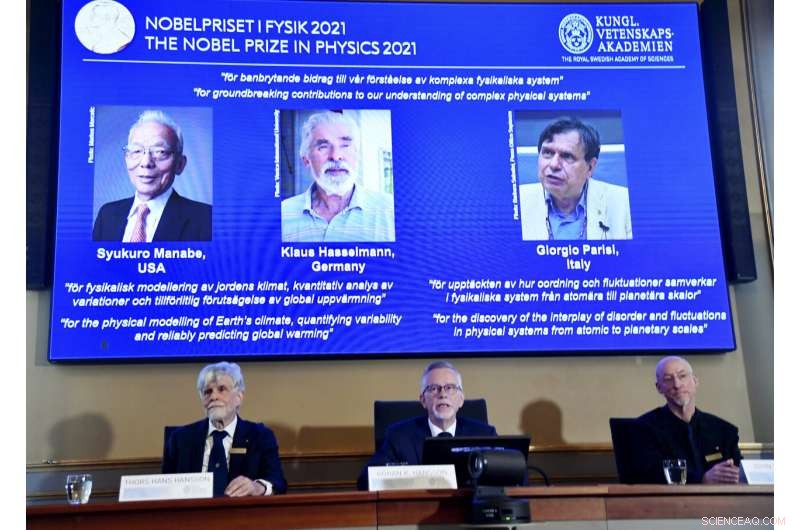
Secrétaire général de l'Académie royale des sciences de Suède Goran Hansson, centre, flanqué à gauche du membre du Comité Nobel de physique Thors Hans Hansson, la gauche, et membre du comité Nobel de physique John Wettlaufer, droit, annonce les lauréats du prix Nobel de physique 2021 à l'Académie royale des sciences de Suède, à Stockholm, Suède, Mardi, 5 octobre 2021. Le prix Nobel de physique a été décerné à des scientifiques du Japon, Allemagne et Italie. Syukuro Manabe et Klaus Hasselmann ont été cités pour leurs travaux sur « la modélisation physique du climat de la Terre, quantifier la variabilité et prédire de manière fiable le réchauffement climatique". La seconde moitié du prix a été décernée à Giorgio Parisi pour "la découverte de l'interaction du désordre et des fluctuations dans les systèmes physiques de l'échelle atomique à l'échelle planétaire." Crédit :Pontus Lundahl/TT via AP
Trois scientifiques ont remporté mardi le prix Nobel de physique pour des travaux qui ont trouvé de l'ordre dans un désordre apparent, aider à expliquer et à prédire les forces complexes de la nature, y compris l'élargissement de notre compréhension du changement climatique.
Syukuro Manabe, originaire du Japon, et Klaus Hasselmann d'Allemagne ont été cités pour leur travail dans le développement de modèles de prévision du climat de la Terre et "prédisant de manière fiable le réchauffement climatique". La seconde moitié du prix a été décernée à Giorgio Parisi d'Italie pour avoir expliqué le désordre dans les systèmes physiques, allant de ceux aussi petits que l'intérieur des atomes à la taille d'une planète.
Hasselmann a déclaré à l'Associated Press qu'il « préférerait ne pas avoir de réchauffement climatique et pas de prix Nobel ».
Manabe a déclaré que comprendre la physique derrière le changement climatique était « 1, 000 fois" plus facile que d'amener le monde à faire quelque chose à ce sujet. Il a déclaré que les complexités de la politique et de la société sont beaucoup plus difficiles à comprendre que les complexités du dioxyde de carbone interagissant avec l'atmosphère, qui change alors les conditions dans l'océan et sur la terre, qui modifie ensuite l'air à nouveau dans un cycle constant.
Il a qualifié le changement climatique de "crise majeure".
Le prix intervient moins de quatre semaines avant le début des négociations de haut niveau sur le climat à Glasgow, Écosse, où les dirigeants mondiaux seront invités à intensifier leurs engagements pour freiner le réchauffement climatique.
Les scientifiques lauréats du prix Nobel ont profité de leur moment sous les projecteurs pour exhorter à l'action.
« Il est très urgent que nous prenions des décisions très fortes et avancions à un rythme très soutenu » pour lutter contre le réchauffement climatique, dit Parisi. Il a lancé l'appel même si sa part du prix était pour des travaux dans un domaine différent de la physique.
Les trois scientifiques travaillent sur ce que l'on appelle des « systèmes complexes, " dont le climat n'est qu'un exemple. Mais le prix a été décerné à deux domaines d'études opposés à bien des égards, bien qu'ils partagent l'objectif de donner un sens à ce qui semble aléatoire et chaotique afin qu'il puisse être prédit.
Les recherches de Parisi se concentrent en grande partie sur les particules subatomiques, prédire comment ils se déplacent de manière apparemment chaotique et pourquoi, et est quelque peu ésotérique, tandis que le travail de Manabe et Hasselmann porte sur les forces mondiales à grande échelle qui façonnent notre vie quotidienne.

Syukuro Manabe, droit, parle aux journalistes à son domicile de Princeton, NEW JERSEY., Mardi, 5 octobre 2021. Manabe et deux autres scientifiques ont remporté le prix Nobel de physique pour des travaux qui ont trouvé de l'ordre dans un désordre apparent, aider à expliquer et à prédire les forces complexes de la nature, y compris l'élargissement de notre compréhension du changement climatique. Crédit :AP Photo/Seth Wenig
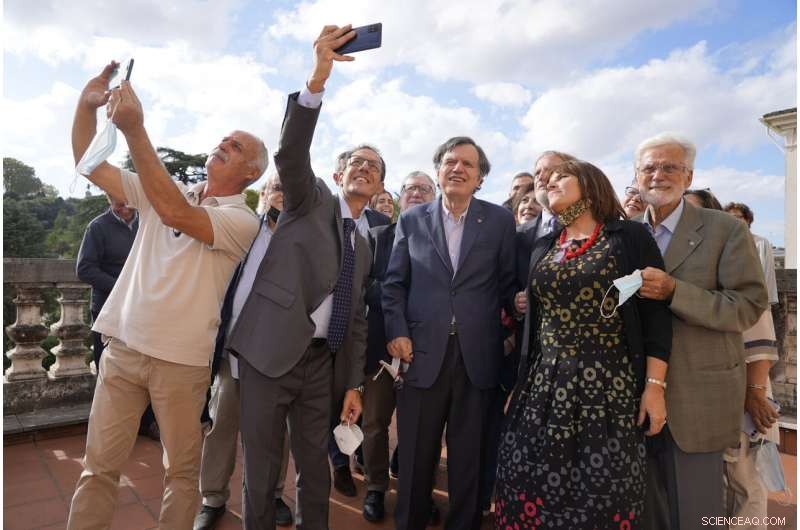
le physicien théoricien italien Giorgio Parisi , centre, pose pour un selfie avec ses collègues de l'Accademia dei Lincei , Mardi, 5 octobre 2021, à Rome, après avoir reçu le prix Nobel de physique 2021, avec Syukuro Manabe et Klaus Hasselmann, par l'Académie royale des sciences de Suède à Stockholm. Crédit :AP Photo/Domenico Stinellis
Les juges ont dit Manabe, 90, et Hasselmann, 89, « a jeté les bases de notre connaissance du climat de la Terre et de la façon dont les actions humaines l'influencent ».
À partir des années 1960, Manabé, maintenant basé à l'Université de Princeton, a créé les premiers modèles climatiques qui prédisent ce qui se passerait lorsque le dioxyde de carbone s'accumulerait dans l'atmosphère.
Depuis des décennies, les scientifiques ont montré que le dioxyde de carbone emprisonne la chaleur, mais le travail de Manabe offrait des détails. Cela a permis aux scientifiques de finalement montrer comment le changement climatique va s'aggraver et à quelle vitesse, en fonction de la quantité de pollution au carbone émise.
Manabe est un tel pionnier que d'autres climatologues ont appelé son article de 1967 avec le regretté Richard Wetherald « l'article sur le climat le plus influent de tous les temps, " a déclaré Gavin Schmidt, modélisateur en chef du climat de la NASA. Le collègue de Manabe à Princeton, Tom Delworth, a qualifié Manabe de " Michael Jordan du climat ".
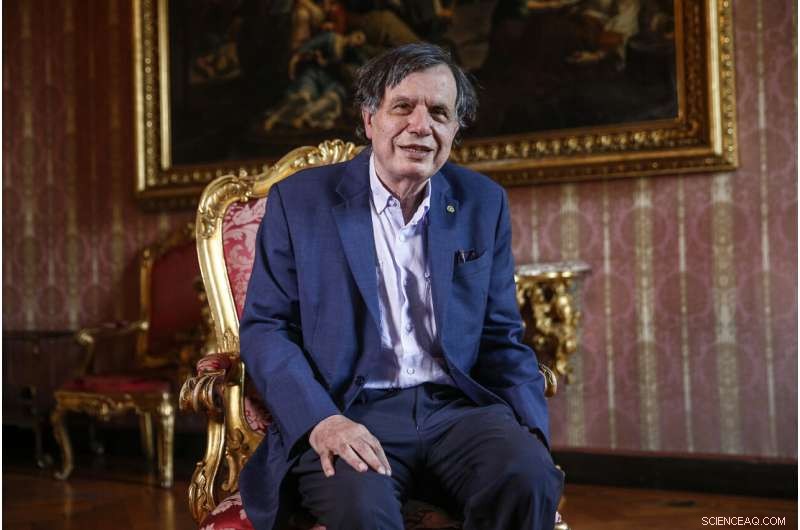
Giorgio Parisi pose pour des photos à Rome, Mardi, 5 octobre 2021. Le prix Nobel de physique a été décerné à des scientifiques du Japon, Allemagne et Italie. Syukuro Manabe et Klaus Hasselmann ont été cités pour leurs travaux sur « la modélisation physique du climat de la Terre, quantifier la variabilité et prédire de manière fiable le réchauffement climatique". La seconde moitié du prix a été décernée à Giorgio Parisi pour "la découverte de l'interaction du désordre et des fluctuations dans les systèmes physiques de l'échelle atomique à l'échelle planétaire." Crédit :Cecilia Fabiano/LaPresse via AP
"Suki a ouvert la voie à la science climatique d'aujourd'hui, pas seulement l'outil mais aussi comment l'utiliser, " a déclaré Gabriel Vecchi, un autre climatologue de Princeton. " Je ne peux pas compter les fois où j'ai pensé avoir trouvé quelque chose de nouveau, et c'est dans un de ses papiers."
Les modèles de Manabe d'il y a 50 ans "ont prédit avec précision le réchauffement qui s'est réellement produit au cours des décennies suivantes, " a déclaré le climatologue Zeke Hausfather du Breakthrough Institute. Le travail de Manabe nous sert " d'avertissement à tous que nous devrions prendre leurs projections d'un avenir beaucoup plus chaud si nous continuons à émettre du dioxyde de carbone très au sérieux ".
"Je n'aurais jamais imaginé que cette chose que je commencerais à étudier ait une conséquence aussi énorme, " Manabe a déclaré lors d'une conférence de presse à Princeton. "Je le faisais juste par curiosité."
Environ une décennie après les premiers travaux de Manabe, Hasselmann, de l'Institut Max Planck de météorologie à Hambourg, Allemagne, a aidé à expliquer pourquoi les modèles climatiques peuvent être fiables malgré la nature apparemment chaotique du temps. Il a également développé des moyens de rechercher des signes spécifiques de l'influence humaine sur le climat.
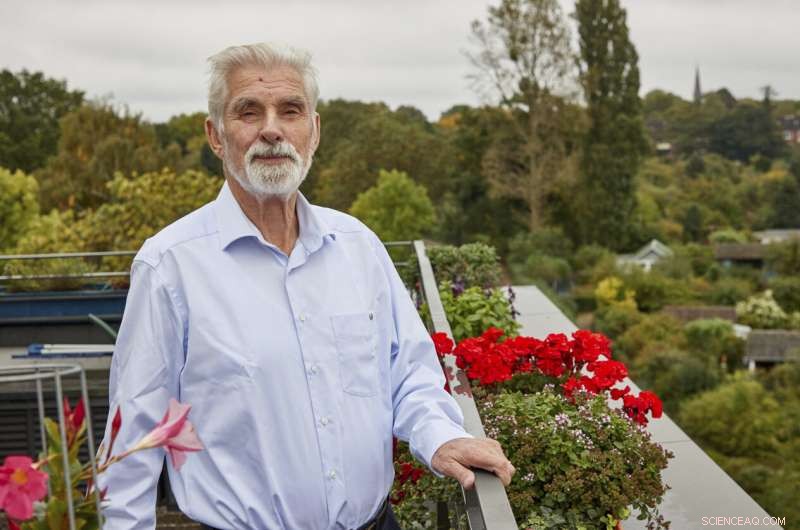
Le chercheur climatique Klaus Hasselmann se tient sur le balcon de son appartement à Hambourg, Allemagne, Mardi, 5 octobre, 2021. Le prix Nobel de physique de cette année revient à l'Allemand Klaus Hasselmann, Syukuro Manabe (USA) et l'Italien Giorgio Parisi pour les modèles physiques du climat de la Terre. Crédit :Georg Wendt/dpa via AP
Pendant ce temps, Parisi, de l'Université La Sapienza de Rome, "construire un modèle physique et mathématique profond" qui a permis de comprendre des systèmes complexes dans des domaines aussi différents que les mathématiques, la biologie, neurosciences et apprentissage automatique.
Son travail se concentrait à l'origine sur ce qu'on appelle le verre de spin, un type d'alliage métallique dont le comportement a longtemps déconcerté les scientifiques. Parisi, 73, découvert des modèles cachés qui expliquaient la façon dont il agissait, créer des théories qui pourraient être appliquées à d'autres domaines de recherche, trop.
Les trois physiciens ont utilisé des mathématiques complexes pour expliquer et prédire ce qui semblait être des forces chaotiques de la nature. C'est ce qu'on appelle la modélisation.
"Les modèles climatiques basés sur la physique ont permis de prédire l'ampleur et le rythme du réchauffement climatique, y compris certaines des conséquences comme la montée des mers, augmentation des précipitations extrêmes et des ouragans plus forts, des décennies avant qu'ils ne puissent être observés, " a déclaré le climatologue et modélisateur allemand Stefan Rahmstorf. Il a qualifié Hasselmann et Manabe de pionniers dans ce domaine.
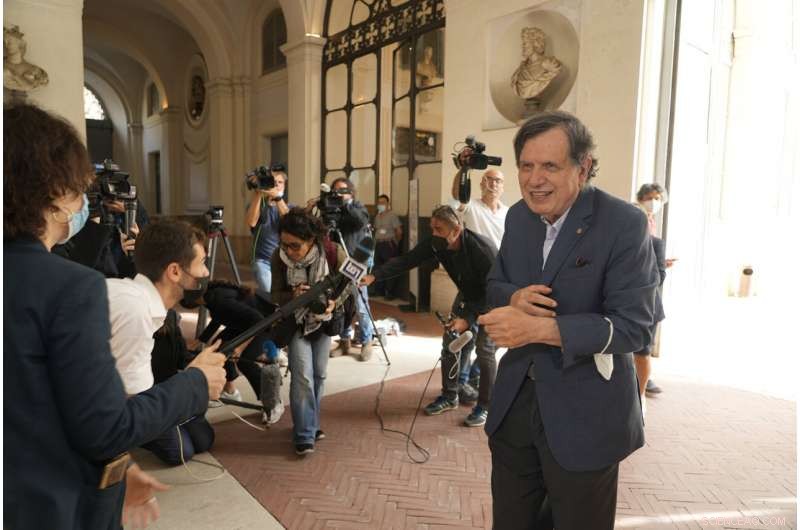
Le physicien théoricien italien Giorgio Parisi s'adresse aux journalistes à son arrivée à l'Accademia dei Lincei , Mardi, 5 octobre 2021, à Rome, après avoir reçu le prix Nobel de physique 2021, avec Syukuro Manabe et Klaus Hasselmann, par l'Académie royale des sciences de Suède à Stockholm. Crédit :AP Photo/Domenico Stinellis
Lorsque les climatologues du Groupe d'experts intergouvernemental sur l'évolution du climat des Nations Unies et l'ancien vice-président américain Al Gore ont remporté le prix Nobel de la paix 2007, certains qui nient le réchauffement climatique l'ont rejeté comme un geste politique. Anticipant peut-être la controverse, membres de l'Académie suédoise des sciences, qui décerne le Nobel, a souligné que celui de mardi était un prix scientifique.
"Ce que nous disons, c'est que la modélisation du climat est solidement basée sur la théorie physique et la physique bien connue, ", a déclaré le physicien suédois Thors Hans Hansson lors de l'annonce.
Pour un scientifique qui fait le commerce des prédictions, Hasselmann a déclaré que le prix l'avait pris au dépourvu.
"J'ai été assez surpris quand ils ont appelé, " dit-il. " Je veux dire, c'est quelque chose que j'ai fait il y a de nombreuses années."
Mais Parisi a déclaré :"Je savais qu'il y avait une possibilité non négligeable" de gagner.

Syukuro Manabe s'adresse aux journalistes à son domicile de Princeton, NEW JERSEY., Mardi, 5 octobre 2021. Manabe et deux autres scientifiques ont remporté le prix Nobel de physique pour des travaux qui ont trouvé de l'ordre dans un désordre apparent, aider à expliquer et à prédire les forces complexes de la nature, y compris l'élargissement de notre compréhension du changement climatique. Crédit :AP Photo/Seth Wenig

Le physicien théoricien italien Giorgio Parisi s'adresse aux journalistes à son arrivée à l'Accademia dei Lincei , Mardi, 5 octobre 2021, à Rome, après avoir reçu le prix Nobel de physique 2021, avec Syukuro Manabe et Klaus Hasselmann, par l'Académie royale des sciences de Suède à Stockholm. Crédit :AP Photo/Domenico Stinellis

Syukuro Manabe s'adresse aux journalistes à son domicile de Princeton, NEW JERSEY., Mardi, 5 octobre 2021. Manabe et deux autres scientifiques ont remporté le prix Nobel de physique pour des travaux qui ont trouvé de l'ordre dans un désordre apparent, aider à expliquer et à prédire les forces complexes de la nature, y compris l'élargissement de notre compréhension du changement climatique. Crédit :AP Photo/Seth Wenig
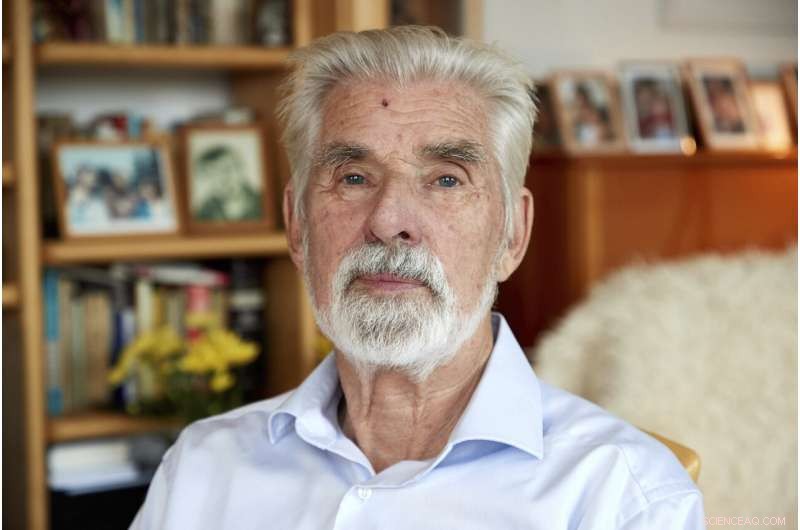
Le chercheur climatique Klaus Hasselmann est assis dans son appartement à Hambourg, Allemagne, Mardi, 5 octobre, 2021. Le prix Nobel de physique de cette année revient à l'Allemand Klaus Hasselmann, Syukuro Manabe (USA) et l'Italien Giorgio Parisi pour les modèles physiques du climat de la Terre. Crédit :Georg Wendt/dpa via AP

Le scientifique italien Giorgio Parisi utilise son téléphone sur le balcon de sa maison à Rome, Mardi, 5 octobre 2021. Le prix Nobel de physique a été décerné à des scientifiques du Japon, Allemagne et Italie. Syukuro Manabe et Klaus Hasselmann ont été cités pour leurs travaux sur « la modélisation physique du climat de la Terre, quantifier la variabilité et prédire de manière fiable le réchauffement climatique". La seconde moitié du prix a été décernée à Giorgio Parisi pour "la découverte de l'interaction du désordre et des fluctuations dans les systèmes physiques de l'échelle atomique à l'échelle planétaire." Crédit :AP Photo/Alessandra Tarantino

Giorgio Parisi, centre, ouvre une bouteille de vin mousseux à l'institution scientifique Accademia dei Lincei à Rome, Mardi, 5 octobre 2021. Le prix Nobel de physique a été décerné à des scientifiques du Japon, Allemagne et Italie. Syukuro Manabe et Klaus Hasselmann ont été cités pour leurs travaux sur « la modélisation physique du climat de la Terre, quantifier la variabilité et prédire de manière fiable le réchauffement climatique". La seconde moitié du prix a été décernée à Giorgio Parisi pour "la découverte de l'interaction du désordre et des fluctuations dans les systèmes physiques de l'échelle atomique à l'échelle planétaire." Crédit :Cecilia Fabiano/LaPresse via AP
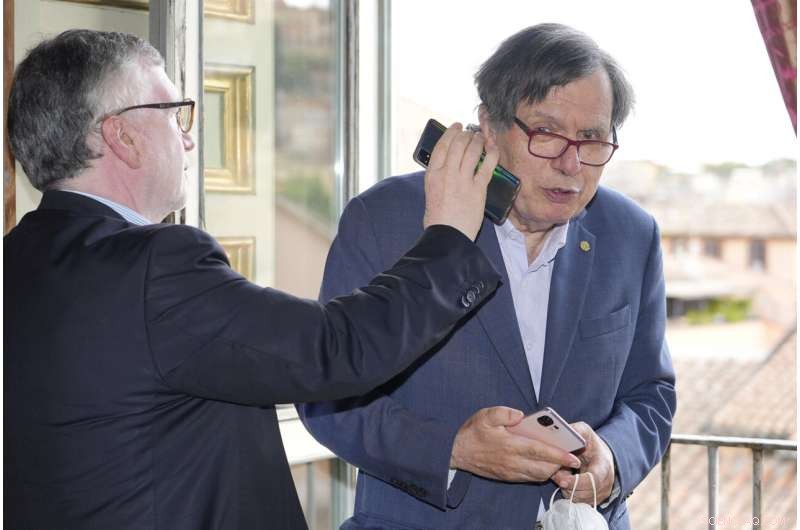
le physicien théoricien italien Giorgio Parisi, droit, est passé des appels téléphoniques par son collègue Massimo Inguscio, président du Conseil national italien de la recherche, à son arrivée à l'Accademia dei Lincei, Mardi, 5 octobre 2021, à Rome, après avoir reçu le prix Nobel de physique 2021, avec Syukuro Manabe et Klaus Hasselmann, par l'Académie royale des sciences de Suède à Stockholm. Crédit :AP Photo/Domenico Stinellis

Les piétons prennent des copies d'une édition supplémentaire du journal Yomiuri, le scientifique Syukuro Manabe a reçu le prix Nobel de physique 2021 à Tokyo, Mardi, 5 octobre 2021. Crédit :AP Photo/Koji Sasahara
Le prix est accompagné d'une médaille d'or et de 10 millions de couronnes suédoises (plus de 1,14 million de dollars). L'argent provient d'un legs laissé par le créateur du prix, L'inventeur suédois Alfred Nobel, décédé en 1895.
Le lundi, le Nobel de médecine a été décerné aux Américains David Julius et Ardem Patapoutian pour leurs découvertes sur la façon dont le corps humain perçoit la température et le toucher.
Au cours des prochains jours, des prix seront décernés dans les domaines de la chimie, Littérature, paix et économie.
******
Communiqué du Comité Nobel :Le prix Nobel de physique 2021
L'Académie royale des sciences de Suède a décidé de décerner le prix Nobel de physique 2021
« pour des contributions révolutionnaires à notre compréhension des systèmes physiques complexes »
avec la moitié conjointement à
Syukuro Manabe
Université de Princeton, Etats-Unis
Klaus Hasselmann
Institut Max Planck de météorologie, Hambourg, Allemagne
"pour la modélisation physique du climat terrestre, quantifier la variabilité et prévoir de manière fiable le réchauffement climatique"
et l'autre moitié à
Giorgio Parisi
Université La Sapienza de Rome, Italie
"pour la découverte de l'interaction du désordre et des fluctuations dans les systèmes physiques de l'échelle atomique à l'échelle planétaire"
Physique pour le climat et d'autres phénomènes complexes
Trois lauréats se partagent le prix Nobel de physique de cette année pour leurs études de phénomènes chaotiques et apparemment aléatoires. Syukuro Manabe et Klaus Hasselmann ont jeté les bases de notre connaissance du climat de la Terre et de la manière dont l'humanité l'influence. Giorgio Parisi est récompensé pour ses contributions révolutionnaires à la théorie des matériaux désordonnés et des processus aléatoires.
Les systèmes complexes sont caractérisés par l'aléatoire et le désordre et sont difficiles à comprendre. Le Prix de cette année récompense de nouvelles méthodes pour les décrire et prédire leur comportement à long terme.
One complex system of vital importance to humankind is Earth's climate. Syukuro Manabe demonstrated how increased levels of carbon dioxide in the atmosphere lead to increased temperatures at the surface of the Earth. Dans les années 1960, he led the development of physical models of the Earth's climate and was the first person to explore the interaction between radiation balance and the vertical transport of air masses. His work laid the foundation for the development of current climate models.
About ten years later, Klaus Hasselmann created a model that links together weather and climate, thus answering the question of why climate models can be reliable despite weather being changeable and chaotic. He also developed methods for identifying specific signals, fingerprints, that both natural phenomena and human activities imprint in he climate. His methods have been used to prove that the increased temperature in the atmosphere is due to human emissions of carbon dioxide.
Around 1980, Giorgio Parisi discovered hidden patterns in disordered complex materials. His discoveries are among the most important contributions to the theory of complex systems. They make it possible to understand and describe many different and apparently entirely random materials and phenomena, not only in physics but also in other, very different areas, such as mathematics, la biologie, neuroscience and machine learning.
"The discoveries being recognised this year demonstrate that our knowledge about the climate rests on a solid scientific foundation, based on a rigorous analysis of observations. This year's Laureates have all contributed to us gaining deeper insight into the properties and evolution of complex physical systems, " says Thors Hans Hansson, chair of the Nobel Committee for Physics.
Popular information
They found hidden patterns in the climate and in other complex phenomena
Three Laureates share this year's Nobel Prize in Physics for their studies of complex phenomena. Syukuro Manabe and Klaus Hasselmann laid the foundation of our knowledge of the Earth's climate and how humanity influences it. Giorgio Parisi is rewarded for his revolutionary contributions to the theory of disordered and random phenomena.
All complex systems consist of many different inter-acting parts. They have been studied by physicists for a couple of centuries, and can be difficult to describe mathematically – they may have an enormous number of components or be governed by chance. They could also be chaotic, like the weather, where small deviations in initial values result in huge differences at a later stage. This year's Laureates have all contributed to us gaining greater knowledge of such systems and their long-term development.
The Earth's climate is one of many examples of complex systems. Manabe and Hasselmann are awarded the Nobel Prize for their pioneering work on developing climate models. Parisi is rewarded for his theoretical solutions to a vast array of problems in the theory of complex systems.
Syukuro Manabe demonstrated how increased concentrations of carbon dioxide in the atmosphere lead to increased temperatures at the surface of the Earth. Dans les années 1960, he led the development of physical models of the Earth's climate and was the first person to explore the interaction between radiation balance and the vertical transport of air masses. His work laid the foundation for the development of climate models.
About ten years later, Klaus Hasselmann created a model that links together weather and climate, thus answering the question of why climate models can be reliable despite weather being changeable and chaotic. He also developed methods for identifying specific signals, fingerprints, that both natural phenomena and human activities imprint in the climate. His methods have been used to prove that the increased temperature in the atmosphere is due to human emissions of carbon dioxide.
Around 1980, Giorgio Parisi discovered hidden patterns in disordered complex materials. His discoveries are among the most important contributions to the theory of complex systems. They make it possible to understand and describe many different and apparently entirely random complex materials and phenomena, not only in physics but also in other, very different areas, such as mathematics, la biologie, neuroscience and machine learning.
The greenhouse effect is vital to life
Two hundred years ago, French physicist Joseph Fourier studied the energy balance between the sun's radiation towards the ground and the radiation from the ground. He understood the atmosphere's role in this balance; at the Earth's surface, the incoming solar radiation is transformed into outgoing radiation – "dark heat" – which is absorbed by the atmosphere, thus heating it. The atmosphere's protective role is now called the greenhouse effect. This name comes from its similarity to the glass panes of a greenhouse, which allow through the heating rays of the sun, but trap the heat inside. Cependant, the radiative processes in the atmosphere are far more complicated.
The task remains the same as that undertaken by Fourier – to investigate the balance between the shortwave solar radiation coming towards our planet and Earth's outgoing longwave, infrared radiation. The details were added by many climate scientists over the following two centuries. Contemporary climate models are incredibly powerful tools, not only for understanding the climate, but also for understanding the global heating for which humans are responsible.
These models are based on the laws of physics and have been developed from models that were used to predict the weather. Weather is described by meteorological quantities such as temperature, precipitation, wind or clouds, and is affected by what happens in the oceans and on land. Climate models are based upon the weather's calculated statistical properties, such as average values, standard deviations, highest and lowest measured values, etcetera. They cannot tell us what the weather will be in Stockholm on 10 December next year, but we can get some idea of what temperature or how much rainfall we can expect on average in Stockholm in December.
Establishing the role of carbon dioxide
The greenhouse effect is essential for life on Earth. It governs temperature because the greenhouse gases in the atmosphere – carbon dioxide, methane, water vapour and other gases – first absorb the Earth's infrared radiation and then release this absorbed energy, heating up the surrounding air and the ground below it.
Greenhouse gases actually comprise a very small proportion of the Earth's dry atmosphere, which is largely nitrogen and oxygen – these are 99 per cent by volume. Carbon dioxide is just 0.04 per cent by volume. The most powerful greenhouse gas is water vapour, but we cannot control the concentration of water vapour in the atmosphere, while we can control that of carbon dioxide.
The amount of water vapour in the atmosphere is highly dependent on temperature, leading to a feed-back mechanism. More carbon dioxide in the atmosphere makes it warmer, allowing more water vapour to be held in the air, which increases the greenhouse effect and makes temperatures rise even further. If the carbon dioxide level drops, some of the water vapour will condense and the temperature will fall.
An important first piece of the puzzle about the impact of carbon dioxide came from Swedish researcher and Nobel Laureate Svante Arrhenius. Incidemment, it was his colleague, meteorologist Nils Ekholm who, in 1901, was the first to use the word greenhouse in describing the atmosphere's storage and re-radiation of heat.
Arrhenius understood the physics responsible for the greenhouse effect by the end of the 19th century – that outgoing radiation is proportional to the radiant body's absolute temperature (T) to the power of four (T⁴). The hotter the source of the radiation, the shorter the rays' wavelength. The Sun has a surface temperature of 6, 000°C and primarily emits rays in the visible spectrum. Terre, with a surface temperature of just 15°C, re-radiates infrared radiation that is invisible to us. If the atmosphere did not absorb this radiation, the surface temperature would barely exceed –18°C.
Arrhenius was actually attempting to work out what caused the recently discovered phenomenon of ice ages. He arrived at the conclusion that if the level of carbon dioxide in the atmosphere halved, this would be enough for the Earth to enter a new ice age. And vice versa – a doubling of the amount of carbon dioxide would increase the temperature by 5–6°C, a result which, somewhat fortuitously, is astoundingly close to current estimates.
Pioneering model for the effect of carbon dioxide
Dans les années 1950, Japanese atmospheric physicist Syukuro Manabe was one of the young and talented researchers in Tokyo who left Japan, which had been devastated by war, and continued their careers in the US. The aim of Manabes's research, like that of Arrhenius around seventy years earlier, was to understand how increased levels of carbon dioxide can cause increased temperatures. Cependant, while Arrhenius had focused on radiation balance, in the 1960s Manabe led work on the development of physical models to incorporate the vertical transport of air masses due to convection, as well as the latent heat of water vapour.
To make these calculations manageable, he chose to reduce the model to one dimension – a vertical column, 40 kilometres up into the atmosphere. Toutefois, it took hundreds of valuable computing hours to test the model by varying the levels of gases in the atmosphere. Oxygen and nitrogen had negligible effects on surface temperature, while carbon dioxide had a clear impact:when the level of carbon dioxide doubled, global temperature increased by over 2°C.
The model confirmed that this heating really was due to the increase in carbon dioxide, because it predicted rising temperatures closer to the ground while the upper atmosphere got colder. If variations in solar radiation were responsible for the increase in temperature instead, the entire atmosphere should have been heating at the same time.
Sixty years ago, computers were hundreds of thousands of times slower than they are now, so this model was relatively simple, but Manabe got the key features right. You must always simplify, il dit. You cannot compete with the complexity of nature – there is so much physics involved in every raindrop that it would never be possible to compute absolutely everything. The insights from the onedimensional model led to a climate model in three dimensions, which Manabe published in 1975; this was yet another milestone on the road to understanding the climate's secrets.
Weather is chaotic
About ten years after Manabe, Klaus Hasselmann succeeded in linking together weather and climate by finding a way to outsmart the rapid and chaotic weather changes that were so troublesome for calculations. Our planet has vast shifts in its weather because solar radiation is so unevenly distributed, both geographically and over time. Earth is round, so fewer of the sun's rays reach the higher latitudes than the lower ones around the Equator. Not only this, but the Earth's axis is tilted, producing seasonal differences in incoming radiation. The differences in density between warmer and colder air cause the colossal transports of heat between different latitudes, between ocean and land, between higher and lower air masses, which drive the weather on our planet.
Comme nous le savons tous, making reliable predictions about the weather for more than the next ten days is a challenge. Two hundred years ago, the renowned French scientist, Pierre-Simon de Laplace, stated that if we just knew the position and speed of all the particles in the universe, it should be possible to both calculate what has happened and what will happen in our world. En principe, this should be true; Newton's three-century old laws of motion, which also describe air transport in the atmosphere, are entirely deterministic – they are not governed by chance.
Cependant, nothing could be more wrong when it comes to the weather. This is partly because, en pratique, it is impossible to be precise enough – to state the air temperature, pressure, humidity or wind conditions for every point in the atmosphere. Aussi, the equations are nonlinear; small deviations in initial values can make a weather system evolve in entirely different ways. Based on the question of whether a butterfly flapping its wings in Brazil could cause a tornado in Texas, the phenomenon was named the butterfly effect. En pratique, this means that it is impossible to produce long-term weather forecasts – the weather is chaotic; this discovery was made in the 1960s by the American meteorologist Edward Lorenz, who laid the foundation of today's chaos theory.
Making sense of noisy data
How can we produce reliable climate models for several decades or hundreds of years into the future, despite weather being a classic example of a chaotic system? Around 1980, Klaus Hasselmann demonstrated how chaotically changing weather phenomena can be described as rapidly changing noise, thus placing long-term climate forecasts on a firm scientific foundation. Par ailleurs, he developed methods for identifying human impact on the observed global temperature.
As a young doctoral student in physics in Hamburg, Allemagne, in the 1950s, Hasselmann worked on fluid dynamics, then began to develop observations and theoretical models for ocean waves and currents. He moved to California and continued with oceanography, meeting colleagues such as Charles David Keeling, with whom the Hasselmanns started a madrigal choir. Keeling is legendary for beginning, back in 1958, what is now the longest series of atmospheric carbon dioxide measurements at the Mauna Loa Observatory in Hawaii. Little did Hasselmann know that in his later work he would regularly use the Keeling Curve, which shows changes in the carbon dioxide levels.
Obtaining a climate model from noisy weather data can be illustrated by walking a dog:the dog runs off the lead, backwards and forwards, side to side and around your legs. How can you use the dog's tracks to see whether you are walking or standing still? Or whether you are walking quickly or slowly? The dog's tracks are the changes in the weather, and your walk is the calculated climate. Is it even possible to draw conclusions about long-term trends in the climate using chaotic and noisy weather data?
One additional difficulty is that the fluctuations that influence the climate are extremely variable over time – they may be rapid, such as in wind strength or air temperature, or very slow, such as melting ice sheets and warming oceans. Par exemple, uniform heating by just one degree can take a thousand years for the ocean, but just a few weeks for the atmosphere. The decisive trick was incorporating the rapid changes in the weather into the calculations as noise, and showing how this noise affects the climate.
Hasselmann created a stochastic climate model, which means that chance is built into the model. His inspiration came from Albert Einstein's theory of Brownian motion, also called a random walk. Using this theory, Hasselmann demonstrated that the rapidly changing atmosphere can actually cause slow variations in the ocean.
Discerning traces of human impact
Once the model for climate variations was finished, Hasselmann developed methods for identifying human impact on the climate system. He found that the models, along with observations and theoretical considerations, contain adequate information about the properties of noise and signals. Par exemple, changes in solar radiation, volcanic particles or levels of greenhouse gases leave unique signals, fingerprints, which can be separated out. This method for identifying fingerprints can also be applied to the effect that humans have on the climate system. Hasselman thus cleared the way to further studies of climate change, which have demonstrated traces of human impact on the climate using a large number of independent observations.
Climate models have become increasingly refined as the processes included in the climate's complicated interactions are mapped more thoroughly, not least through satellite measurements and weather observations. The models clearly show an accelerating greenhouse effect; since the mid-19th century, the levels of carbon dioxide in the atmosphere have increased by 40 per cent. Earth's atmosphere has not contained this much carbon dioxide for hundreds of thousands of years. Par conséquent, temperature measurements show that the world has heated by 1°C over the past 150 years.
Syukuro Manabe and Klaus Hasselmann have contributed to the greatest benefit for humankind, in the spirit of Alfred Nobel, by providing a solid physical foundation for our knowledge of Earth's climate. We can no longer say that we did not know – the climate models are unequivocal. Is Earth heating up? Oui. Is the cause the increased amounts of greenhouse gases in the atmosphere? Oui. Can this be explained solely by natural factors? No. Are humanity's emissions the reason for the increasing temperature? Oui.
Methods for disordered systems
Around 1980, Giorgio Parisi presented his discoveries about how apparently random phenomena are governed by hidden rules. His work is now considered to be among the most important contributions to the theory of complex systems.
Modern studies of complex systems are rooted in the statistical mechanics developed in the second half of the 19th century by James C. Maxwell, Ludwig Boltzmann and J. Willard Gibbs, who named this field in 1884. Statistical mechanics evolved from the insight that a new type of method was necessary for describing systems, such as gases or liquids, that consist of large numbers of particles. This method had to take the particles' random movements into account, so the basic idea was to calculate the particles' average effect instead of studying each particle individually. Par exemple, the temperature in a gas is a measure of the average value of the energy of the gas particles. Statistical mechanics is a great success, because it provides a microscopic explanation for macroscopic properties in gases and liquids, such as temperature and pressure.
The particles in a gas can be regarded as tiny balls, flying around at speeds that increase with higher temperatures. When the temperature drops, or pressure increases, the balls first condense into a liquid and then into a solid. This solid is often a crystal, where the balls are organised in a regular pattern. Cependant, if this change happens rapidly, the balls may form an irregular pattern that does not change even if the liquid is further cooled or squeezed together. If the experiment is repeated, the balls will assume a new pattern, despite the change happening in exactly the same way. Why are the results different?
Understanding complexity
These compressed balls are a simple model for ordinary glass and for granular materials, such as sand or gravel. Cependant, the subject of Parisi's original work was a different kind of system – spin glass. This is a special type of metal alloy in which iron atoms, par exemple, are randomly mixed into a grid of copper atoms. Even though there are only a few iron atoms, they change the material's magnetic properties in a radical and very puzzling manner. Each iron atom behaves like a small magnet, ou tourner, which is affected by the other iron atoms close to it. In an ordinary magnet, all the spins point in the same direction, but in a spin glass they are frustrated; some spin pairs want to point in the same direction and others in the opposite direction – so how do they find an optimal orientation?
In the introduction to his book about spin glass, Parisi writes that studying spin glass is like watching the human tragedies of Shakespeare's plays. If you want to make friends with two people at the same time, but they hate each other, it can be frustrating. This is even more the case in a classical tragedy, where strongly emotional friends and enemies meet on stage. How can the tension in the room be minimised?
Spin glasses and their exotic properties provide a model for complex systems. Dans les années 1970, many physicists, including several Nobel Laureates, searched for a way to describe the mysterious and frustrating spin glasses. One method they used was the replica trick, a mathematical technique in which many copies, replicas, of the system are processed at the same time. Cependant, in terms of physics, the results of the original calculations were unfeasible.
In 1979, Parisi made a decisive breakthrough when he demonstrated how the replica trick could be ingeniously used to solve a spin glass problem. He discovered a hidden structure in the replicas, and found a way to describe it mathematically. It took many years for Parisi's solution to be proven mathematically correct. Depuis, his method has been used in many disordered systems and become a cornerstone of the theory of complex systems.
The fruits of frustration are many and varied Both spin glass and granular materials are examples of frustrated systems, in which various constituents must arrange themselves in a manner that is a compromise between counteracting forces. The question is how they behave and what the results are. Parisi is a master at answering these questions for many different materials and phenomena. His fundamental discoveries about the structure of spin glasses were so deep that they not only influenced physics, but also mathematics, la biologie, neuroscience and machine learning, because all these fields include problems that are directly related to frustration.
Parisi has also studied many other phenomena in which random processes play a decisive role in how structures are created and how they develop, and dealt with questions such as:Why do we have periodically recurring ice ages? Is there a more general mathematical description of chaos and turbulent systems? Or – how do patterns arise in a murmuration of thousands of starlings? This question may seem far removed from spin glass. Cependant, Parisi has said that most of his research has dealt with how simple behaviours give rise to complex collective behaviours, and this applies to both spin glasses and starlings.
Advanced information:www.nobelprize.org/prizes/phys … dvanced-information/
© 2021 La Presse Associée. Tous les droits sont réservés. Ce matériel ne peut pas être publié, diffuser, réécrit ou redistribué sans autorisation.